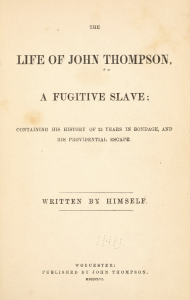John Thompson
Writer, Freedom Seeker, Seaman, Man of great faith
(1812 – ?)

“I was born in Maryland, in 1812, and was slave to a Mrs. Wagar” were the first words of John Thompson’s autobiography, The Life of John Thompson, A Fugitive Slave: Containing His History of Twenty-Five Years in Bondage, and His Providential Escape, Written by Himself. Born during the War of 1812, Thompson grew up with his parents and six siblings on a tobacco plantation in Southern Maryland. His first memory of enslavement was at six years old when he and his mother visited his sister held in a pen at a trader’s yard before the slavers shipped her South. This was when he realized he was enslaved.
Thompson secretly learned to read and write from a young student when he walked his charge to school. As he grew older, Thompson’s literacy skills allowed him access to the Bible and religion. Along with other enslaved persons, the newly formed Methodist Meetings interested Thompson on Sundays.
Once authorities discovered he could read and write, they instructed slave patrols to pay close attention to Thompson. Constables arrested him twice on charges that he wrote “passes” for other enslaved people. Because of these arrests and rumors that his enslaver planned to sell him, Thompson decided to seek his freedom in the North. He put his trust in God, praying for courage and protection along the escape route. He fled Southern Maryland with the help of Black freeman and the Underground Railroad.
When he reached Philadelphia, he married and attended night school to advance his literacy skills until “several slaves nearby were arrested and taken to the South” (p. 103). He had to leave his wife and escape to New Bedford, Massachusetts. There he found safety at sea. He travelled on a whaling vessel for two years as far as New Zealand and the Coast of Africa.
Returning to Massachusetts, he joined his wife and settled down to write his autobiography. His narrative is full of details of an enslaved life. He writes in his book that he avoids the attempts of white writers to portray “slavery in such glowingly beautiful colors” (p. 441).
Like many slave-narrative authors, Thompson stressed the arbitrary violence of daily life and the dehumanizing effects of slavery on both slave and master. His early memories portray acts of barbarism inflicted on the slave population by members of the Wagar family, both children and adults. He also writes about nineteenth century whaling and the different people and cultures he met on his travels. In his book he provides detailed descriptions of the whaling industry. Although little is known about John Thompson outside of his autobiography, he fills his book with memories of the enslaved African Americans and a great love of God.
Did You Know?
- Although no Maryland laws were enacted to prevent enslaved people from learning to read, most enslavers prohibited it.
- Methodist organizing among Black people started as early as 1790 when Methodist preachers would hold prayer meetings for enslaved and free Blacks in Southern Maryland.
Additional Resources
Digital text of John Thompson’s autobiography by Documenting the American South. https://docsouth.unc.edu/neh/thompson/summary.html
https://enslaved.org/fullStory/16-23-126843/
Journal of Slavery and Data Preservation (ISSN 2691-297X) is a digital academic journal that publishes datasets and accompanying data articles about the lives of enslaved Africans and their descendants from the fifteenth to the early twentieth centuries. https://jsdp.enslaved.org/
Thompson, John. The Life of John Thompson, A Fugitive Slave; Containing His History of Twenty-five Years in Bondage, and His Providential Escape, Written by Himself. Worcester, Mass.: J. Thompson, 1856. Book.
https://openlibrary.org/books/OL13519298M/The_life_of_John_Thompson_a_fugitive_slave